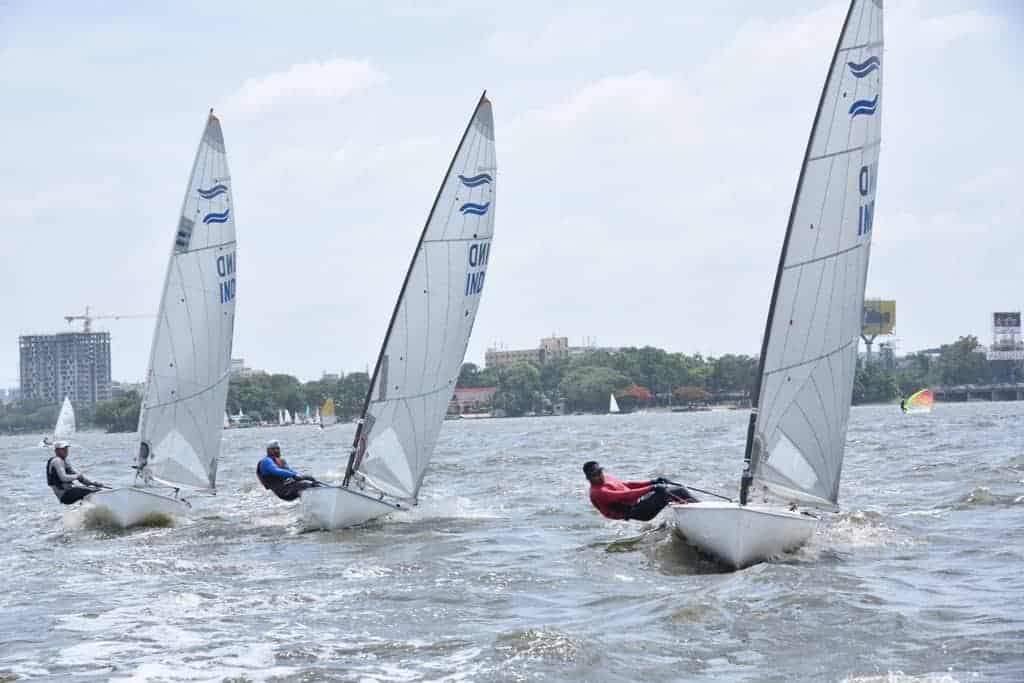Only the Covid outbreak last year could beach the boats in over half a century at the EME Sailing Association (EMESA) that has not only produced two time Asian Games bronze medallist Rajesh Choudhary, other international and national medallists but also globally renowned officials and administrators of Mother Earth’s most eco-friendly sport. Following is the first in a three-part series.
By A. Joseph Antony
Hyderabad: Hussain Sagar, the arena of the action, came into being when Hazrat Hussain Shah Wali, during the reign of Ibrahim Qutub Shah built a bund in 1562 on the Balkapur river, a tributary of the Musi, on the banks of which the historic city earlier took shape. Four hundred years later, one could track, with naked eye, a coin take a tumble right to the bottom of the reservoir.
Fishermen continued to make a living for a decade or two more. Akin to biting the hand that feeds, degradation of the water body then began, entirely man-made, now rendering visibility six inches below the surface, well nigh impossible. Successive governments have shirked their responsibilities to clean up the lake, so polluted by industrial effluents and even human waste.
The mushrooming of multi-storied buildings around the reservoir has made the vagaries of weather, especially the wind patterns, more unpredictable. This factor alone makes competitions here all the more challenging.
Even if the scenario at times is depressing, what is heartening is that for over four decades, the conduct of competitions has rarely fallen short of meticulous. Much credit for the organizational efficiency goes to the dedication of the army, which holds the annual championship against all odds and despite operating on shoestring budgets.
Ironically, for all the crocodile tears shed for soldiers dying on the border, the indifference especially from the corporate world to sponsoring this sport/event here can be shocking. Most often, the meagre sponsorship that the regattas get is in piecemeal format and comes at the eleventh hour.
Picturesque club house
At the picturesque club house, the yacht’s image is ever-present, be it on glass or wooden doors or as a backdrop to various stages adorning the scenic premises sited on the shores of the over 400-year-old water body. No establishment in the country can lay a greater claim to the sport’s growth at the grass-root level than the EME Sailing Association (EMESA) in Secunderabad.
To say its beginnings were humble would be an understatement. Formed in November 1964 with Major General S.P. Vohra, the Director, EME (DEME) as its Patron and Brigadier G.R. Chainani as the Commodore, it was attached to the Military College of Electronics and Mechanical Engineering (MCEME) at Secunderabad but had no boats of its own.
Sailors such as S. Dutta, A.A. Basith, I.S. Kahai, P.S. Pannu, B.S. Ramdas & T.S. Rekhi kept the interest going, indulging their passion at the Secunderabad Sailing Club or the Defence Services Sailing Club (DSSC) at Okhla, near Delhi. Recognition was accorded to the EMESA by the Yachting Association of India (YAI) in 1965.
The no-boats handicap notwithstanding, EME sailors acquitted themselves honourably, participating in national regattas from 1965 itself. Rekhi was third in the 1966 All India Regatta, rising to runner-up in 1969. In the following year Basith represented the country in the South Asian Yachting Regatta (SAYR) at Colombo and was joined by Kahai in the next edition.
In 1969, the first two CBK Class boats, Titlee and Mala were purchased and launched in Okhla and later shifted to Secunderabad. EME then began manufacturing boats and the first five Enterprise Class boats were made in an Army Base Workshop under the guidance of Basith. These were named Basanti, Manjula, Rajam, Sitara and Urmila and were launched in Hussain Sagar Lake in 1972.
The surge in the performance of EME sailors soon became visible. Basith represented India in the 1972 Munich Olympics in the Flying Dutchman class while Kahai came close to claiming the prestigious Katari Bowl, the national crown in the Enterprise class. D.S. Dikhit donned India colours at the 1982, 1986 Asian Games in New Delhi and Seoul, South Korea respectively. So was he the National wind surfing champion for several years since 1981.
In 1984, due to the persistent efforts of Major Gen. Gokhale, the Commodore, and Lt. Col. M.P. Jaggi, Honorary Secretary, a piece of land adjacent to the Youth Hostel was allotted to the EMESA. Most of the current facilities came up thanks to the sustained endeavours of Lt. Gen. Tripat Singh, Commodore and Secretary Kahai.
The good work was carried on by dedicated officers such as Jagdish Singh, K.S. Saini, S. Rajaram, Jayaraman, R.B. Jadeja, Anil Das, Milind Prabhu, R.S. Dhillon, A.G. Shirodkar, S.S. Siwatch and Bhuwan Khare among others.
To be continued…
A. Joseph Antony is a Hyderabad-based sports journalist and author of ‘My way–The biography of M.L. Jaisimha’ (Amazon, Apple Books). Previously, he was a Senior Assistant Editor with The Hindu in Hyderabad.

